The 6 Best Brain Games for Dogs
- Anja Boecker
- Updated: 2023-12-20
Want to add some variety to your time together? Does your dog seem underchallenged? Want to keep his cute little head busy? Then you've come to the right place! Here are 6 brain games and other dog activities you can try with your pet to have fun together.
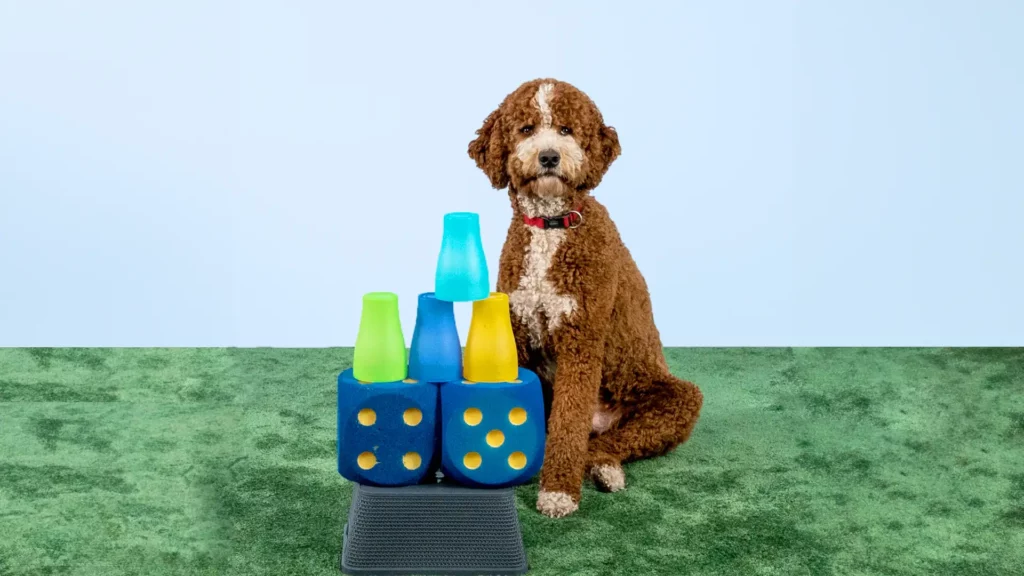
Why Dog Activities Are So Important
Have you ever wondered why brain games are so important for your dog? More than just a pastime, brain games are the key to your dog's mental stimulation and health.
Just like you, your dog can get bored. A little variety in your activities can help. In addition to walks, your four-legged friend needs mental exercise to be a balanced companion in everyday life.
Physical activity is essential for your dog's health, but mental stimulation is just as important. Brain games challenge your dog's brain and keep him mentally active and engaged.
Brain games exercise your dog's brain and develop his problem-solving and decision-making skills. Joint activities during brain games strengthen the bond between you and your dog and promote mutual understanding.
Mental challenges can reduce behavioral problems caused by boredom or stress. Brain games provide meaningful activity and help put excess energy to good use.
If your pet does not have enough to do, it will quickly get into silly thoughts. He usually shows his boredom by doing things that are forbidden. For example, he may knock over the garbage can or turn your shoes into a toy.
Scolding your dog is not the answer. You need to get to the root of the problem. You can do this by mixing up the day with brain games. You'll see how much fun your little friend will have.
Advantages & Benefits
Brain games are not only fun for your dog, they also play an important role in his mental health and overall well-being.
1. Mental Stimulation
Brain games keep your dog's brain active and engaged. They help maintain mental agility and promote mental skills. Brain games encourage your dog's natural curiosity and urge to explore.
2. Problem-Solving Skills
Brain games encourage your dog's cognitive development by challenging him to solve problems and learn new skills. With each puzzle or game solved, your dog's confidence grows. Success in brain games can help him feel more confident and competent.
3. Reduce Stress
Brain games are a constructive way to reduce stress and anxiety. They give the dog a task to focus on, which helps to calm his mind. Regular mental challenges prevent boredom, which often leads to destructive behavior.
4. Promoting Wellness
By solving puzzles and overcoming challenges, these games promote your dog's overall emotional well-being. Brain games provide a varied activity that enriches your dog's daily life and brings him joy.
How to Keep Your Dog Busy Through Play
A dog needs to be kept busy. You've probably heard this many times. But how do you do it? What does a dog like to do? How do you know it enjoys something?
The answer is both simple and complicated: Try different things. Does your dog like to dig into things? Does he like to follow exciting scents? Does he like to think around corners to get to the big reward?
The easiest way to find out is to try different games with your pet. Your pet will be happy if you spend time with him. Prepare a game for him and see if he accepts it gratefully or if he doesn't really know what to do with it.
The frequency and difficulty of the brain games your dog needs can be roughly inferred from the breed. Ultimately, however, each dog has an individual character and its own interests that it enjoys. You know your pet best. Together, you can find out what his favorite game is.
What Are the Different Types of Dog Activity?
Dogs can be kept busy in several ways. There is physical activity and there is mental activity. For a balanced dog, it is important to provide a little bit of both.
Physical exercise is often easy to achieve. For many dogs, daily walks are enough. If not, you can take them biking, jogging, playing ball, or trying dog sports like agility.
Only mental training raises questions for many dog owners. What exactly does it mean? Dogs are very intelligent creatures. Of course, that intelligence needs to be challenged! This is done through training, teaching your dog new tricks, but also through play.
When your dog smells something, his brain is working overtime. Searching for something with your sense of smell is fun for your loyal companion. At the same time, it can be quite exhausting. You can take advantage of this by keeping him on his toes with little brain teasers.
# 1) Simple Brain Games
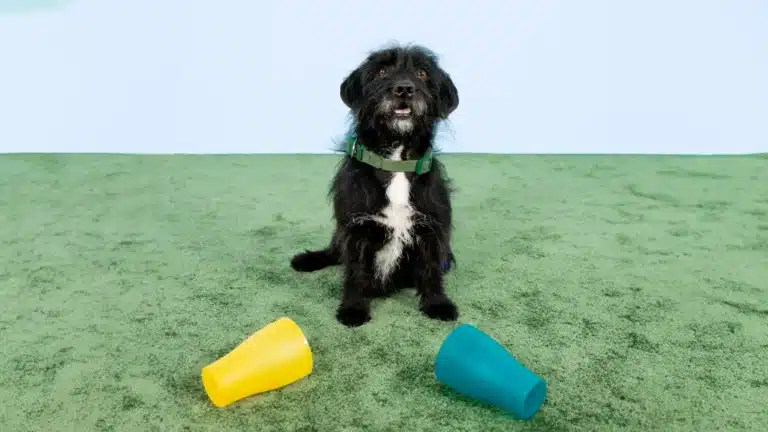
Brain games are a great way to keep your dog mentally challenged and entertained. Best of all, many brain games don't require special toys or equipment. Here are some simple but effective brain games you can try with your dog.
Hide and Seek With Treats
Hide some treats in your house or yard while your dog watches. Then give him the command to find them. This game develops your dog's sniffing skills and encourages him to actively explore his surroundings.
Cup Game
Use three cups or small bowls and hide a treat under one of the cups. Have your dog watch you move the cups and see if he can guess which cup the treat is under. This game develops your dog's attention and memory.
Name Learning Game
Name a specific toy and show it to your dog. Then hide it in a simple hiding place and ask your dog to retrieve the toy by name. Your dog will learn to name toys, which will improve his cognitive skills.
"Which Hand" Game
Hide a treat in one hand. Hold both hands closed in front of your dog and let him guess which hand the treat is in. This game develops your dog's decision-making skills and sense of smell.
Simple Search Tasks
Hide a favorite toy or treat in an easily accessible place and send your dog on a search. This type of game builds your dog's independence and problem-solving skills.
#2) Interactive Toys and Puzzles
Interactive toys and puzzles are a great way to develop your dog's thinking skills while having fun.
Food Dispenser
These toys release treats or food when your dog manipulates them in a certain way, such as rolling or shaking. They encourage natural hunting and problem-solving skills and provide hours of playtime fun.
Puzzle Boards
Puzzle boards consist of different compartments in which treats can be hidden. The dog must figure out how to get to the treats, often by moving, lifting, or rotating puzzle pieces. These puzzles require concentration and patience and provide a challenging mental activity.
Intelligence Toys
These toys are often more complex and require a series of actions to reach the hidden food. They can include sliding elements, rotating mechanisms, or multi-step puzzles. They encourage critical thinking and are ideal for dogs looking for an advanced challenge.
Sniffer Mats / Sniffer Carpet
Sniffer mats are fabric mats with lots of hiding places for treats. The dog has to work with his nose to find the treats. These mats encourage your dog's sense of smell and provide a natural and calming activity. You can also make this brain teaser yourself. Just use a deep pile carpet to hide treats.
Interactive Food Balls, Rings and Kongs
Some interactive toys are in the form of balls or rings that challenge the dog mentally and physically by encouraging it to roll, chase, and think. These toys combine physical activity with mental stimulation and are ideal for active dogs.
Providing your dog with a selection of interactive toys and puzzles will not only add variety to his daily routine, but will also actively promote his mental health and well-being. These types of toys can help prevent boredom and provide a meaningful and satisfying activity for your dog.
#3) Homemade Brain Games
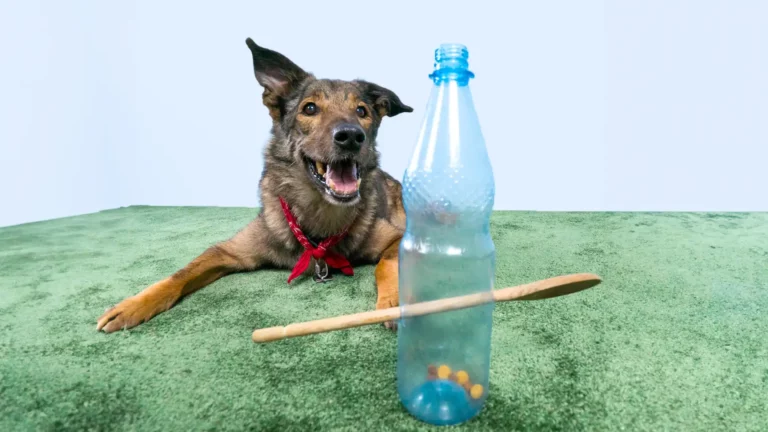
You don't have to spend a lot of money to challenge your dog mentally. There are many easy and inexpensive ways to make your own brain games. Here are some creative ideas you can try out at home.
Homemade Sniffing Box
You will need a box, old towels, or scraps of fabric. Crumple up the towels or rags and hide treats inside. Then let your dog sniff through the box looking for the treats. It encourages scent recognition and provides a fun search task.
Spin the Bottle
You will need a sturdy plastic bottle and a stick or broom handle. Punch holes in the bottle, fill it with treats, and place it on the stick. The dog must learn to turn the bottle to get the treats. It trains problem-solving and dexterity.
Cardboard Maze
You will need several boxes and treats. Build a small maze out of the boxes and hide treats inside. Your dog will have to work his way through the maze to find the treats. This helps develop spatial awareness and problem-solving skills.
Cup and Ball Game
You will need several cups and a small ball or other toy. Hide the ball under one of the cups and then mix them up. Your dog has to guess which cup the ball is under. The goal is to improve observation and decision-making skills.
DIY Agility Course
You will need household items such as chairs, broomsticks, or cushions. Create a simple agility course in your backyard or living room. Guide your dog through the course and reward him for his efforts. It combines physical activity with a mental challenge.
These homemade brain games are a great way to keep your dog challenged without spending a lot of money. Not only do they promote your dog's mental fitness, but they are also a wonderful way to have fun together and deepen your bond.
#4) Training Games for Mental Development
Training games that develop both physical and mental skills are a great way to keep your dog fit and healthy. Not only are these games entertaining, but they are also extremely useful in promoting your dog's cognitive and physical development. Here are some suggestions for incorporating games into your daily routine.
Get With Commands
Combine fetch with basic commands such as sit, down, or stay. Give your dog a command before throwing the toy. This encourages physical activity as well as obedience and focus.
Hide and Seek
Hide yourself or a toy and let your dog find you or the toy. Train your dog's sniffing and problem-solving skills while encouraging exercise.
Agility Training at Home
Build a simple agility course using everyday objects. Guide your dog through different stations such as slaloms, jumps or tunnels. It improves physical dexterity while developing understanding of instructions and concentration.
Trick Training
Teach your dog new tricks like "paw", "roll over", or "sit pretty". It increases cognitive flexibility while improving coordination and balance.
Food Ball Games
Use a food ball that releases treats when moved. Let your dog figure out how to get the treat. Combines physical activity with mental challenge and builds problem-solving skills.
These training games are a great way to break up your dog's daily routine while challenging him mentally and physically. They not only strengthen the bond between you and your dog, but also contribute to a healthy and balanced lifestyle.
#5) Games for Advanced Learners
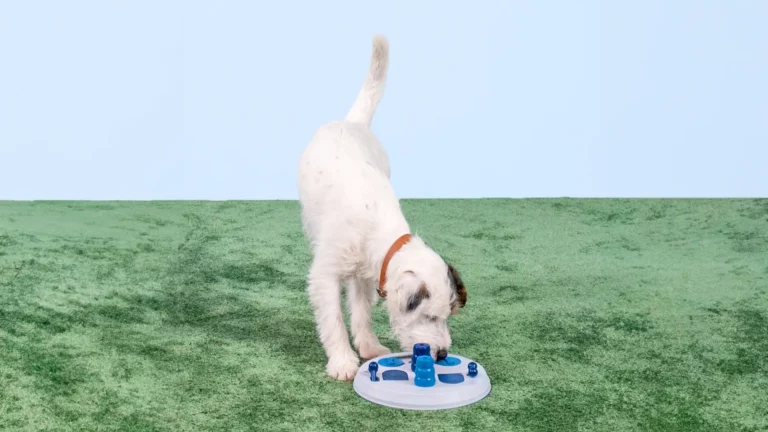
For dogs who already have experience with brain games, there are challenging activities that will further develop and challenge their skills. Here are some ideas for advanced brain games that will help your dog take his cognitive skills to the next level.
Hide-And-Seek for Advanced Players
Increase the difficulty of hide-and-seek games by hiding treats or toys in hard-to-reach places. You can also use multiple hiding places at the same time. Train your dog's problem-solving skills and stamina.
Complex Trick Training
Combine multiple tricks into a trick chain that requires your dog to perform multiple commands in a specific order. The goal is to develop memory and the ability to perform complex tasks.
Interactive Puzzle Toy
Use more complex puzzle toys that require multiple steps to reach the reward. These can be twist and slide mechanisms or multistep puzzles. The goal should be to encourage cognitive flexibility and strategic thinking.
Recovering with Obstacles
Incorporate obstacles such as jumps or tunnels into the retrieval game. Your dog must retrieve the toy while overcoming the obstacles. It combines physical skill with a mental challenge.
Odor Differentiation
Teach your dog to discriminate between different smells and find the right object based on its scent. It trains your dog's sense of smell and promotes concentration.
These advanced games not only provide your dog with a mental challenge, but also strengthen your bond as you work together on complex tasks. These activities keep your dog mentally active and prevent boredom by providing constant challenges.
Too theoretical for you? If you prefer a visual approach, our app gives you more ideas for brain games with step-by-step video instructions. Learn more about our app here.
3 Indoor Brain Games
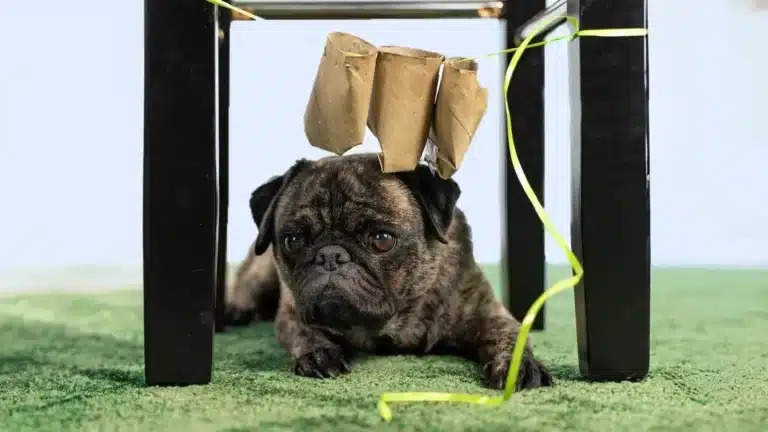
Maybe there's a thunderstorm outside, the summer heat hits you in the face as soon as you leave the house, or you just want to spend time with your dog at home. There are also great brain-teasers that are easy to organize and will keep your furry friend busy.
Game #1: Take Off Socks
You only need three things to play this game: old socks, a clothesline (or something similar), and treats. First, fill the socks with treats. Hang the clothesline where your dog can easily reach it.
Now hang the socks loosely over the clothesline so your dog can easily pull them down. Let him try on his own first. If he gets stuck, encourage him and show him that the socks are super interesting and worth pulling until they fall off.
If your dog has trouble understanding the game at first, you can reward him with treats when he removes a sock. When he has mastered the game, you can let him work out his own reward by taking the treat out of the sock. The sock can also be torn.
Once your dog gets the hang of it, increase the difficulty. Hang the clothesline a little higher so your pet has to jump to catch a sock, or wrap the socks a little tighter around the clothesline so they are harder to unhook.
Game #2: Treasure Chest
This game uses your dog's nose. You will need a crate of the correct height for your dog, socks, newspaper, and treats. The crate should be just high enough for your dog to easily stick his head over the edge and his snout to reach the bottom of the crate.
Fill the box with socks, crumpled newspaper, or similar material. Hide some treats between the socks and newspaper so your pet can't see them directly.
Place the box in front of your dog and let him search. He will follow the scent of the treats and sniff through the box to find them. This brainteaser is really easy to set up and most dogs enjoy it.
Game #3: Rotating Rollers
To play this game, you will need some rolls of cardboard, string, tape, scissors, and treats. First, fold each roll in half on one side so nothing can fall out. Secure this end with tape to keep it in place.
Next, use the scissors to cut a small hole in each roll. Now thread all the rolls together on the string. Tie the string at the height of your dog's head, such as between two table legs. The open side of the rolls should be facing up.
Place a treat in each roll. Your dog must now try to push the rolls with his nose or paw to flip them over and drop the treat on the floor. If he doesn't understand the game at first, turn the rolls yourself or point at them. This will teach your dog that he has to move them to get the treat.
3 Outdoor Brain Games
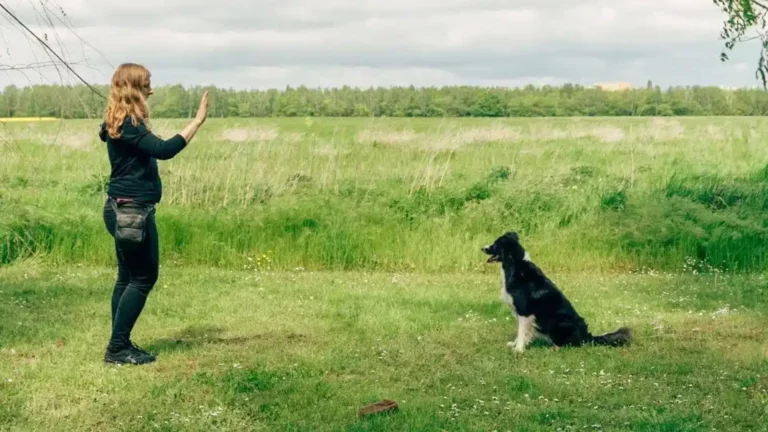
If regular walks are too monotonous for you and your faithful companion, why not add a fun puzzle game every now and then? You're guaranteed to have more fun on your outings together, and your pet will be mentally challenged when you get home.
Game #1: Search for Clues
You will need your dog's favorite treats to play this game. Be sure to play this game only in an area that you know or have thoroughly searched. This will protect your pet from dangerous objects and toxic waste.
Place a good-smelling treat on the ground. Begin by placing a treat every few feet along the trail. This way, your dog will always have a small reward as he searches. At the end of the trail should be your dog's favorite treat - the big jackpot. Be overjoyed when he reaches it. This will also show him that he has done everything right.
Start with 5-6 meters for the first few trials. Concentrated sniffing is very hard on your dog's head. Over time you can increase the distance. Well trained dogs can do up to 100 meters and more. The goal is always the jackpot at the end of the track.
Game No. 2: Forest Search Game
This brain teaser is perfect for those times when you want to take a walk in the woods. Take treats and your dog's favorite toy and turn the woods into your playground.
Put your four-legged friend down and let him watch you hide his toys and some treats. You can use logs, moss, and twigs, among other things. Once you have created a few hiding places, send your dog out to find the rewards.
Praise him with extra words when he finds something you hid. He needs to remember where you've been and use his nose to find the treats and toys. This will train your furry friend.
Game #3: Triangle Exercise
All you need to play this game is a toy and some treats. Make sure you have checked the field where you are playing for dangerous objects. This will ensure safety.
Instruct your dog to sit in one corner of the imaginary triangle and stay there. Now place a toy or treat in the second corner of the triangle. Say "no" so your dog knows he cannot go there.
Now stand in the third corner of your playing field. Call your dog to you. He should resist the impulse to run straight to the exciting treat. When your dog comes to you, praise him verbally before taking a treat from your pocket and giving it to him.
Then send your dog to the corner with the toy or treat. This is his big reward for resisting the initial temptation and obeying your command. After a few successful trials, make the triangle smaller and smaller.
This way, the distance to the toy/treat gets smaller and smaller, and your faithful friend has to work harder and harder to resist the tempting corner of the triangle until you give him permission.
If you are good at the game, you can toss the toy in the corner. The quick movement encourages your dog to play. But your dog must resist and, as always, come to you first.
Implementation and Security
Brain games are a great way to keep your dog mentally challenged and entertained. However, it is important to consider some safety issues to ensure that your dog is protected while playing.
Supervision During the Game
Always stay close and watch your dog while he is playing mind games to make sure he doesn't get frustrated or put himself in danger. Watch for signs of stress or overexertion, such as excessive panting, restlessness, or lack of interest. Stop playing if your dog shows signs of stress.
Choose Safe Toys
Choose toys that are appropriate for your dog's size and chewing habits. Avoid small parts that could be swallowed. Inspect the toy regularly for damage such as cracks or loose parts that could pose a hazard.
Adapting to Your Dog
Adapt games to your dog's age, abilities, and interests. Not every game is appropriate for every dog. Start with simple tasks and slowly increase the level of difficulty to avoid overwhelming your dog.
Take Adequate Breaks
Give your dog plenty of time to relax and recover between brain games. Keep play sessions short, especially if the games are challenging, to avoid mental fatigue.
Use Positive Reinforcement
Use positive reinforcement to show your dog that he is on the right track. Praise and treats can be very motivating.
Frequently Asked Questions
Yes, even dogs can get bored. They usually look for something to do themselves. These are often forbidden things.
Your dog needs your attention every day. How much you should play together varies from dog to dog. For some, 2-3 short games a week are enough in addition to walks, while others like to be kept busy for 1-2 hours a day.
There's not much room in the house for big games, but there are plenty of small brain games that can be played indoors. See our article for suggestions.
Every dog has different game preferences. You can find out what your furry friend likes best by trying different games. However, a mix of physical and mental activity is important for any four-legged friend.
Conclusion
There are many different ways to keep your dog occupied. Games don't have to be complicated. As soon as your favorite needs to use his nose, his little head is hard at work.
Every dog needs physical and mental activity, but they are all individuals. One dog's favorite game may not be of interest to another. Be creative and try different brain games with your dog. You will discover a new favorite game together.
Share Now:

My name is Anja Boecker, and I am a certified dog trainer and behavior consultant. With these articles, I want to help you to understand your dog better and to build an inseparable bond.

